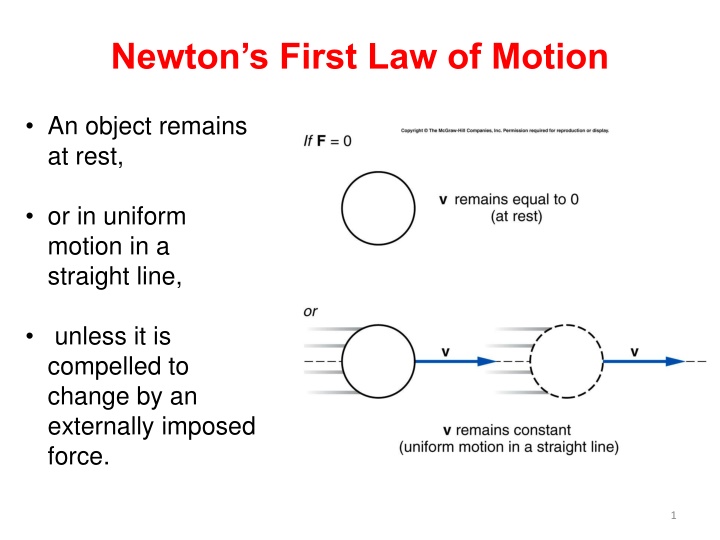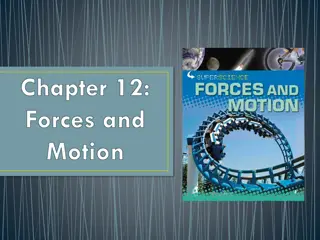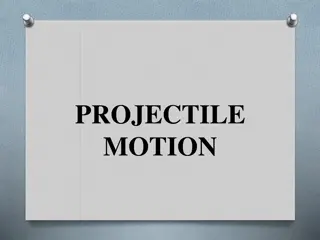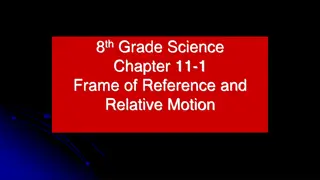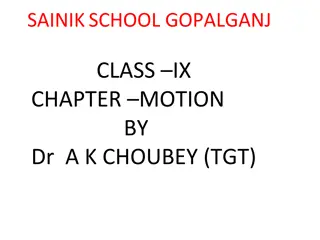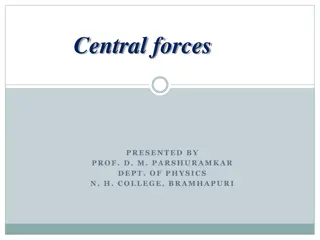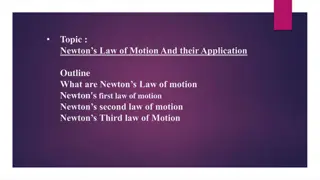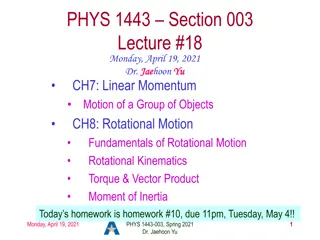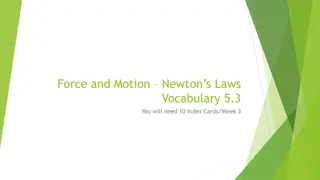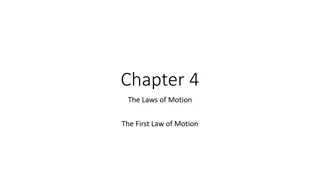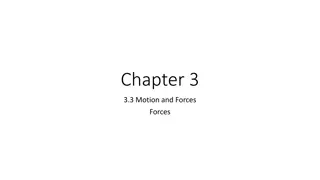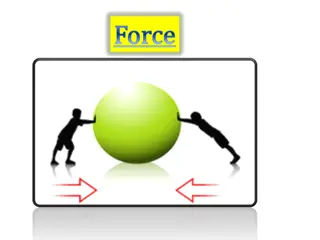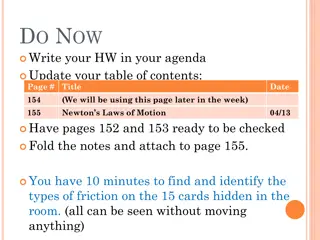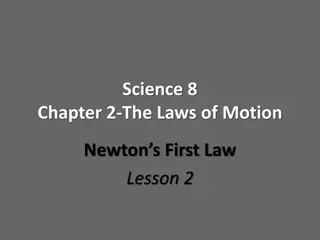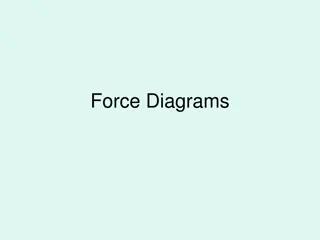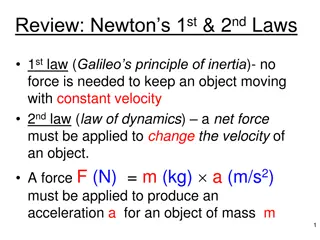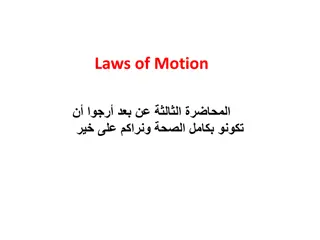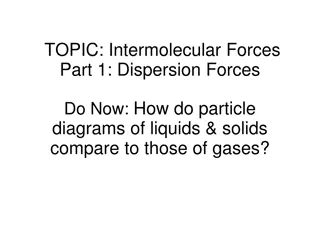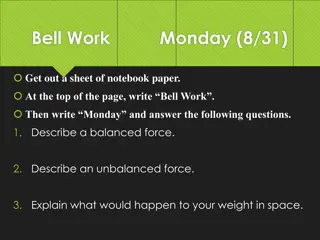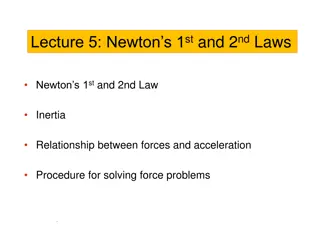Laws of Motion and Forces Explained with Examples
Newton's Three Laws of Motion and key concepts regarding forces are discussed in this content. It includes explanations, visual aids, and quiz questions to test understanding. Topics covered range from object behavior at rest or in motion to calculations involving forces and accelerations. Additionally, there is a question about a skydiver's acceleration in relation to air resistance.
Download Presentation

Please find below an Image/Link to download the presentation.
The content on the website is provided AS IS for your information and personal use only. It may not be sold, licensed, or shared on other websites without obtaining consent from the author.If you encounter any issues during the download, it is possible that the publisher has removed the file from their server.
You are allowed to download the files provided on this website for personal or commercial use, subject to the condition that they are used lawfully. All files are the property of their respective owners.
The content on the website is provided AS IS for your information and personal use only. It may not be sold, licensed, or shared on other websites without obtaining consent from the author.
E N D
Presentation Transcript
Newtons First Law of Motion An object remains at rest, or in uniform motion in a straight line, unless it is compelled to change by an externally imposed force. 1
Newtons Second Law of Motion The acceleration of an object is directly proportional to the magnitude of the imposed force and inversely proportional to the mass of the object. The acceleration is the same direction as that of the imposed force. F = ma units : 1 newton = 1 N = 1 kg m s2 2
Newtons Third Law ( action/reaction ) For every action (force), there is an equal but opposite reaction (force). 3
Quiz: A vertical force of 6N presses on a book of 0.4kg weight on a table. What is the gravitational force and the normal force ? g N a). Gravitational Force = mg = 3.92 N 6 N Normal Force = 6 + 0 = 6.0 N 0.4 kg b). Gravitational Force = mg = 0.4 N Normal Force = 6 + 0.4 = 6.4 N c). Gravitational Force = mg = 6 N Normal Force = 6 + 0.4 = 6.4 N d). Gravitational Force = mg = 3.92 N Normal Force = 6 + 3.92 = 9.92 N 10/6/2024 4 4
Ch 4 CP6 A 60kg person accelerating UP at 1.4m/s2 a) What is the true weight (W)? b) What is the net force (F)? c) What is N? d) What is the apparent weight (AW)? a). W = 588 N, F = 84 N, N = 672 N, AW = 504 N N 1.4 m/s2 Mg b). W = 588 N, F = 84 N, N = 672 N, AW = 672 N c). W = 588 N, F = 84 N, N = 504 N, AW = 504 N d). W = 60 N, F = 84 N, N = 14 N, AW = 14 N e). W = 60 N, F = 84 N, N = 144 N, AW = 144 N 5
Ch 4 CP6 A 60kg person accelerating UP at 1.4m/s2 a) What is the true weight? b) What is the net force? c) What is N? d) What is the apparent weight? N 1.4 m/s2 Mg a) True weight = mg = 60 x 9.8 = 588 N b) Net Force = Ma = 84 N c) N = 588 +84 = 672N d) 672N 10/6/2024 6 6
Does a sky diver continue to accelerate? (hint: air resistance increase with velocity) a). Yes, V increase till he reach the ground b). No. V decrease till he reach the ground c). No. after a certain time V will remain constant till he reach the ground. 7
Does a sky diver continue to accelerate? (hint: air resistance increase with velocity) a). Yes, V increase till he reach the ground b). No. V decrease till he reach the ground c). No. after a certain time V will remain constant till he reach the ground. Air resistance R is a force directed upward, that opposes the gravitational force W Rincreases as the sky diver s velocity increases When R has increased to the magnitude of W, the net force is zero so the acceleration is zero The velocity is then at its maximum value, the terminal velocity 8
1H-04 Hero's Engine A glass bulb emits steam from small nozzles What happens when the Glass Bulb begins to emit steam? A). Nothing will happen B). It will rotate counterclockwise viewing from above c) It will rotate clockwise viewing from above 10/6/2024 9 9
1H-02 Fan Cart (Action-Reaction) Can a fan attached to a cart propel the cart? Without the sail, the cart moves. With the sail, will the cart move? a) yes. b) No. 10/6/2024 10 10
1H-02 Fan Cart (Action-Reaction) Can a fan attached to a cart propel the cart? Reaction Action INTERNAL FORCES IN A SYSTEM CANCEL EACH OTHER WHEN THE SYSTEM AS A WHOLE IS CONSIDERED. SO IF THE SAIL IS PERPENDICULAR THE FAN DOES NOT MOVE. 10/6/2024 11 11
1H-02 Fan Cart (Action-Reaction) Can a fan attached to a cart propel the cart? If the direction of the fan is reversed, will the carts move? a) yes. b) No. 10/6/2024 12 12
Imagine that you are sitting in a cart with a pile of bricks. How could you use the bricks to get yourself and the cart to move ? A). throw one brick after another out of the cart . B). No way, the cart simply can not move. Because the repulse 13
Which one is a more realistic description of what actually happens. a). Upper b). Lower 14
1H-03 CO2 Rocket Now, if the bricks were the size of molecules. . . What happens when the fire extinguisher rapidly throws out CO 2 molecules ? Will the cart move? A). Yes. B) no. Because the repulse 15
1J-04 Scale Paradox 1 A Scale Measures the Force acting on it NOW, What is the reading on the scale ? What is the reading on the scale ? WALL mg mg mg A). Same reading B). Reading double since there are two weights instead of one. C). Reading will be zero since the two weights are equal. 16
1J-04 Scale Paradox 1 A Scale Measures the Force acting on it NOW, What is the reading on the scale ? What is the reading on the scale ? WALL mg mg mg T T T T mg T = mg T = mg mg mg mg THE TENSION IN THE CORD IS THE SAME FOR BOTH CASES. THE SCALE MEASURES THE TENSION IN THE CORD. FOR EXAMPLE THE TENSION IN A ROPE IS THE SAME IF TWO PEOPLE PULL ON EACH END WITH FORCE F OR IF ONE PERSON PULLS WITH FORCE F TO A ROPE TIED TO A WALL. mg 10/6/2024 17 17
What happens when objects are connected? Two connected carts with equal mass being accelerated by a force F applied by a string: Both carts must have the same acceleration a which is equal to the net horizontal force divided by the total mass Each cart will have a net force equal to its mass times the acceleration What s the force acting on the 2nd cart? A). 32 N B). 16 N C). 0 N 32 18
What happens when objects are connected? The interaction between the two carts illustrates Newton s third law: m1 exerts a pull of 16 N to the right on m2 m2 exerts an equal and opposite pull of 16 N to the left on m1 32 19
Two masses connected by a string are placed on a fixed frictionless pulley. If m2 is larger than m1, will the two masses accelerate? a) b) c) Yes. No. You can t tell from this diagram. 20
Two blocks tied together by a string are being pulled across the table by a horizontal force. The blocks have frictional forces exerted on them by the table as shown. What is the net force acting on the entire two-block system? a) b) c) d) e) 16 N 36 N 38 N 44 N 46 N The net horizontal force is: 30 N - 6 N - 8 N = 16 N directed to the right. 21
What is the acceleration of this system? The total mass is: The acceleration of the system is: Total force total mass = 16 N 6 kg = 2.67 m/s2directed to the right. 2 kg + 4 kg = 6 kg a) b) c) d) 2.00 m/s2 2.67 m/s2 5.00 m/s2 7.50 m/s2 22
What force is exerted on the 2-kg block by the connecting string? a) b) c) d) e) 16.5 N 11.3 N 38.1 N 44.4 N 46.2 N The net horizontal force on the 2-kg block is: Fnet = ma = 2 kg x 2.67 m/s2 = 5.3 N So the force due to the string is: Fstring = Fnet + 6 N = 11.3 N directed to the right. 23
Quiz: What is the acceleration of the 4-kg block? a) b) c) d) 2.00 m/s2 2.67 m/s2 5.00 m/s2 7.50 m/s2 The net horizontal force on the 4-kg block is: Fnet = 30 N - 8 N - 11.3 N = 10.7 N So the acceleration of the 4-kg block is: a = F m = 10.7 N 4 kg = 2.67 m/s2 directed to the right. 24
